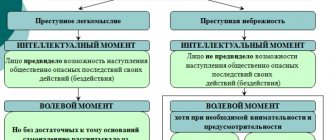Updated July 21, 2022 621 Author: Dmitry Petrov
Hello, dear readers of the KtoNaNovenkogo.ru blog.
Most people periodically experience guilt, but do not realize the reasons for its occurrence or confuse it with other states of mind.
This feeling, like a heavy stone on your chest, does not allow you to relax and engage in everyday activities.
Moral discomfort can help a person change for the better, and sometimes it can destroy life. In this article you will learn how psychologists and lawyers relate to the phenomenon of guilt.
Wine is...
Wine is a multifaceted phenomenon. It affects the intellect and will of the individual, and also entails social consequences.
In the dictionary of Ushakov D.N. There are two definitions of the term:
- as an offense (sin);
- as the cause of something undesirable.
Legal science has partially borrowed such interpretations.
In criminal law, guilt is the attitude of the criminal towards the committed act and the potential socially dangerous consequences. It is one of the elements of the crime. An innocent person cannot be held accountable.
The concept is revealed in a completely different way in psychology.
From the point of view of psychologists, guilt is a negative feeling that arises when a person considers his behavior to be the cause of harm or inconvenience to others.
In this case, the subject is not necessarily really to blame. He can “wind up” himself, for example, out of fear of seeming callous.
Initially, a feeling of guilt arises in a child aged 3-5 years, when he begins to assimilate social norms.
The mechanism looks something like this:
- The child commits an offense that is condemned by society, for example, taking away toys from the children.
- Parents or educators say: “You can’t take someone else’s things. You are a bad boy".
- The child experiences moral discomfort and begins to fear criticism from others in the future.
- The situation with misconduct is repeated repeatedly, and the reaction “analysis of consequences → fear → guilt” is fixed in the subconscious.
Guilt should be distinguished from two related feelings: annoyance and shame . All three phenomena entail similar sensations, but differ in the mechanism of formation.
Frustration occurs when a person realizes the negative consequences of behavior towards himself. For example, he reproaches himself for not being able to overcome laziness, bad habits, or move up the career ladder.
Shame is a consequence of publicity. For example, an employee is ashamed in front of his boss and colleagues for being late for work.
The meaning of guilt
The meaning of the concept of form of guilt is as follows:
What are the types of guilt?
The concept of guilt and its types have been studied in detail in existential psychology . American psychiatrist I.D. Jarlom proposed the following classification depending on the scale of the consequences:
- Neurotic guilt. Arises as a consequence of bad thoughts or minor offenses (for example, not keeping promises). The person experiences mild moral discomfort, which quickly passes.
- Genuine guilt. The individual is faced with deep feelings about the crime that was actually committed. This type of guilt is close to repentance.
- Existential guilt. A person feels guilty for living his life incorrectly, not realizing his abilities, and not achieving his goals. This phenomenon often manifests itself as a “midlife crisis.”
Modern psychologists distinguish two types of guilt: real and false.
Real helps a person rethink his behavior, understand the reasons for internal dissatisfaction, correct mistakes, and improve interpersonal relationships. The absence of real guilt is a sign of infantilism, unhealthy selfishness and other human vices.
False guilt is an irrational reaction that was formed as a result of improper upbringing of a child or unsuccessful life experiences. For example, often a person suffers from remorse for the following imaginary reasons:
- due to being happy;
- due to the lack of opportunity to help loved ones;
- because someone’s life is worse;
- due to the fact that he rested all day, but could have done useful things.
It is necessary to get rid of false guilt. It is important to realize the real reason why negative thoughts arise in your head and let go of the situation.
Otherwise, the false feeling will begin to “corrode” the personality, causing psychosomatic illnesses, difficulties at work, in finances and in the family.
Annotation. The article is devoted to issues related to the offense, various definitions are given, its main features are presented with explanations, types of offenses, types of offenses. The offense is considered in the form of commission and in the form of omission. Illegal behavior is compared with lawful behavior, and it is indicated how these behaviors differ. The article also talks about the composition of offenses and its elements. The concept of guilt as the subjective side of an offense is considered. Its forms and composition are listed, and characteristics of the forms of wine are given. The role of guilt in the study of crime is mentioned.
Key words : offense, elements of the offense, object of the offense, subject of the offense, subjective side
In the modern world there is a constant increase in crime. Modern society is developing, and at the same time new offenses are appearing, the number of which is constantly growing: financial, criminal, constitutional and others. However, the reasons for the offenses have not been fully revealed. This topic needs further study. It affects such a sign of an offense as guilt. Guilt is a person’s internal mental attitude towards the action being performed. It is she who helps to understand the cause of the offense. Guilt manifests itself as a regulator of human behavior, since very often external regulators, that is, laws, are unable to influence people’s behavior or prevent offenses. Not every person is capable of expressing feelings of guilt; it depends on his development and internal upbringing. That is why this topic is relevant, as people are trying to understand when and who may feel guilty.
Studying a person’s ability to express feelings of guilt when offenses occur helps to understand the psychological essence of a person and analyze his behavior. Awareness of guilt plays an important role, since this is what helps speed up the paperwork. Guilt is one of the main internal regulators of human behavior. It is guilt that can have a great influence on the emotional, that is, internal, state of a person.
Also, studying guilt as a regulator of social relations, people try to create various ways to combat crime, trying to achieve high results in crime prevention.
Guilt is the main feature that characterizes the psychological content of the offense. Therefore, it is of interest to many representatives of various legal sciences. For the first time, the concept of guilt was most seriously touched upon in the Council Code[1]. It should be noted that the pre-revolutionary school of domestic criminal law considered the concept of guilt from the psychological perspective. Thus, A.F. Kistyakovsky[2] considered only a crime committed by the subject of his own free will and desire to be criminal and punishable. The famous lawyer N. S. Tagantsev[3] believed that without guilt there will be no liability. Also, the problem of determining guilt is reflected in the works of P. S. Dagel [4], A. V. Kulikov [5], V. N. Kudryavtsev [6], A. I. Plotnikov [7]., A. I. Raroga [8 ], Tkachenko V. I[9], Feldshtein G. S[10], Shiryaeva V. A[11], and many others. Each of them tried to find the source, the reason for the appearance of guilt, the influence of guilt on the psychological state of a person. The importance of Davidovich’s works [12] should be especially emphasized; he argued that guilt is a complex institution of Soviet criminal law.
The offense is inextricably linked with the law. Law is a set of generally binding rules of conduct established or sanctioned by the state, compliance with which is ensured by measures of state influence.[13]
The concept of an offense changes over time and even over short historical periods, as society is constantly developing, thereby changing social traditions and legal values.
Several definitions of the concept “Offense” can be considered.
An offense is a culpable unlawful act committed by a sane person who has reached the legal age.[14]
An offense is an action that violates the law, the law and runs counter to social relations regulated by law.[15]
However, any offense is always a specific act that violates rights, legal laws and is under the control of the will and mind of a person.
Each individual offense reflects reality and is therefore specific, that is, it is committed by a specific person, in a specific place and time, and is contrary to the current legal
prescription. Despite the fact that certain types of offenses have differences, all offenses have common features.
An offense is characterized by a set of characteristics. Four signs have been identified that are mandatory for any type of offense, no matter what rules of law it violates:
- this is a certain act that is under the constant control of a person’s consciousness and will;
- illegality as a violation of objective and subjective law;
- the offender's guilt;
- social harm as a set of negative consequences of an offense.
Offenses as actions are of two types: in the form of commission or in the form of omission. In the first case, a person makes changes that he should not have made. The omission is that a person allows changes to occur that he should have prevented.[16]
The action is determined by the consciousness and will of a person. It is thanks to consciousness that action acquires the character of human behavior. Without consciousness and will there is no behavior, action, deed, and therefore there is no offense.
This sign of offenses allows us to distinguish them from events that are not recognized as offenses, despite their harm.
An indispensable feature of behavior that has legal significance is that it is under the control of the consciousness and will of the person. Consequently, behavior in a state of insanity, incapacity and in all other cases not controlled by the consciousness and will of a person cannot be recognized as an offense.
An offense violates interests protected by law, and thereby harms public and personal interests and the established legal order.
Harm is expressed in the totality of negative consequences of an offense, representing a violation of law and order, disorganization of social relations, destruction of any good, value, subjective right, restriction of their use, restriction of the freedom of behavior of other subjects, contrary to the law.[17] This is the social essence of harm. Its presence is a necessary condition for any offense, since it is harm that characterizes offenses as socially dangerous acts.
The social danger of offenses lies precisely in the fact that they harm the rule of law, public and personal interests. And such harmful consequences are inherent in all offenses. There can be no other offenses except socially dangerous ones, since there are no offenses that would be indifferent and harmless to the state, citizens and society as a whole. Offenses vary in the degree of harmfulness and therefore differ in the degree of social danger.
Following from the very term “offense”, there is such a sign of an offense as illegality. Not every act - action or inaction - is an offense, but only that which is committed contrary to legal dictates violates the law. Wrongfulness distinguishes offenses from lawful acts. Lawful behavior is such behavior that does not contradict the public interests and interests of other persons. Illegal behavior differs from lawful behavior in that it does not comply with, contradicts, or violates the rules of law.
Illegal behavior can be expressed in both action and inaction. From a legal point of view, inaction is not the commission of specific actions that are prescribed to a given subject.
Guilt is also an important feature of a crime. Guilt is conscious in nature, that is, the offender, from all available options for behavior, chose the one that harms society. This mental attitude of the offender to his actions or inactions and their consequences characterizes the unlawful act as guilty.
However, in addition to these four signs, the offense has two more signs that help to more specifically characterize the essence of the offense. Thus, these characteristics include: the capacity for delict and the punishability of a person.
A person’s capacity for tort is manifested in a person’s ability to control his will and his behavior, to give an account of his actions, to be aware of their illegality and to be ready to bear responsibility for their consequences.
All sane persons who have reached a certain age are capable of tort. For example, in the civil and criminal law of the Russian Federation, full legal capacity begins at the age of 18. At the same time, responsibility for certain crimes begins at the age of 14, for administrative offenses and disciplinary offenses - at the age of 16.[18]
Also, as an independent sign of an offense, its punishability is distinguished. This is true for certain types of offenses, for example, criminal, administrative, tax offenses. Previously, this sign of a crime was characteristic of criminal law. The sign of punishability is understood as each fact of committing a crime and the threat of imposing punishment.
Depending on historical circumstances, the same act can be considered both a crime and a misdemeanor.
- A crime is a criminally committed, socially dangerous act prohibited by criminal law under threat of punishment.
- A misdemeanor is an act committed guiltily that does not reach the level of social danger of a crime. (administrative offenses, civil offenses (delicts), disciplinary offenses).[19]
An administrative offense is an unlawful, guilty action or inaction that encroaches on state or public order, property, rights and freedoms of citizens, and the established order of government.
A disciplinary offense is a failure to perform or improper performance of assigned job duties through the fault of an employee.
A civil offense is an illegal action or inaction that violates the norms of objective law and the subjective rights of participants in civil relations.
The above types of offenses, despite some differences, contain common features for all.
Close in content, but not identical to the offense, is the concept of “corpus delicti.”
The concept of “corpus delicti” captures the characteristics inherent in each specific offense, and the concept of “offense” reflects the social essence of the offense, the attitude towards it on the part of society and the state as a whole.
The elements of an offense are a set of objective and subjective characteristics necessary and sufficient to classify an act as an offense and bring the person who committed it to legal liability.
The composition of the offense includes: the object of the offense, the subject of the offense, the objective side of the offense, the subjective side of the offense.
The object of the offense is social relations protected by law, to which harm (damage) is caused or a threat of harm is created as a result of the commission of an unlawful act.
The subject of the offense is a person capable of delinquency who has committed an unlawful act.[20]
Tort capacity of a person - the ability of a person to be responsible for the results of his act
The objective side of an offense is the external manifestation of an unlawful act, including the time, place, consequences and causal relationship between the unlawful act and the socially dangerous consequences that have occurred.
The subjective side of the offense is the mental attitude of the subject to his act and its consequences.
Guilt is the mental attitude of the offender to his actions or inactions, as well as to their consequences, characterizes the unlawful act as guilty, which may include both motives, goals, and emotional elements of the act, which can be taken into account by the legislator both as aggravating and mitigating factors. the fault of circumstances. Guilt is the subjective side of the offense. Wine comes in several forms.
Forms of guilt:
1. Intent.
1.1 Direct intent means that a person is aware and desires the occurrence of socially dangerous consequences of his act.
1.2 Indirect intent means that a person, realizing the wrongfulness of his act, allows the occurrence of socially dangerous consequences.
2. Arrogance means that a person: realizes the wrongfulness of his act, foresees its socially dangerous consequences, and expects to avoid their occurrence.
3. Negligence means that a person: does not realize the wrongfulness of his act, does not foresee its socially dangerous consequences, but due to the circumstances of the case he can and should do this (realize and foresee).
Guilt presupposes the subject's awareness of the meaning of his actions and their consequences, not only as a socially dangerous illegal nature. In this case, it is enough to realize the socially harmful nature of the behavior.
Thus, guilt plays an important role in the study of delinquency. An offense is not only external, but also an internal mental, negative attitude of the violator towards a legal regulation. So, an offense is the guilty illegal behavior of people, which is characterized by certain characteristics characteristic only of it.
Offenses are harmful phenomena. Society, represented by the state, is fighting to eliminate crimes, the causes and conditions that give rise to them, in order to ensure the normal development of society, maintain law and order, and protect public and personal interests.
Since the problem of guilt is one of the most complex in the theory and science of criminal law, it is quite understandable that there are still certain problems and shortcomings in the study of guilt.
Sources and literature used
Gogin A. A. General concept of offenses: problems of methodology, theory and practice: Author's abstract. dis. ...cand. legal Sci. Kazan, 2011. – 173 p.
Zeldov S.I. Offense and legal responsibility. Ordzhonikidze: “Ir”, 1984. – 134 p.
Zlobin G. A., Nikiforov B. S. M.: “Legal Literature”, 1972. – 262 p.
Leksas Ion. Guilt as a subjective side of a criminal act. M.: “Gosporizdat”, 1958. – 86 p.
Malein N. S. Offense: concept, reasons, responsibility. M.: “Legal Literature”, 1985. – 192 p.
Marchenko M. N. Theory of state and law: textbook. 2nd ed. M.: “Prospekt”, 2022. – 656 p.
Mashtakov I.V. Comparative legal characteristics of offenses: Dis. ...cand. legal Sci. Togliatti, 2005. – 211 p.
Nersesyants V. S. General theory of law and state. M.: “Norma”, 1999. – 535 p.
Romashov R. A. Theory of state and law. St. Petersburg: “Urayt”, 2005. – 628 p.
Nizhnik N. S., Semyonova O. V., Karchevskaya N. I., Stotsky A. P., Byalt V. S. Theory of state and law: Textbook. St. Petersburg, 2016. – 244 p.
Kovalev V. A. On the issue of offense as a basis for legal liability // Current problems of Russian law. 2010. No. 3 (16). pp. 27-36.
Footnotes
[1] The Council Code is the first set of laws of the Russian state in Russian history, adopted on January 29, 1649 at the Zemsky Sobor, held in 1648-1649. (https://w.histrf.ru/articles/article/show/sobornoie_ulozhiienieniie)
[2] Kistyakovsky A.F. An elementary textbook of general criminal law with a detailed presentation of the principles of Russian criminal legislation: textbook. — 3rd ed. Kyiv: “Iogansan”, 1891. – 892 p.
[3] Tagantsev N. S. Russian criminal law. General part: T.1. St. Petersburg: “Neva”, 1994. – 672 p.
[4] Dagel P. S., Kotov D. P. Subjective side of the crime and its establishment. Voronezh: “Yuridizdat”, 1974. – 108 s.
[5] Kulikov A.V. Double form of guilt: concept, types, design of compositions, qualification: Abstract of thesis. dis. ...cand. legal Sci. Sverdlovsk, 1990. – 203 p.
[6] Kudryavtseva V.N. Mechanism of criminal behavior. M.: “Legal Literature”, 1981. – 122 p.
[7] Plotnikov A.I. Objective and subjective in criminal law: Assessment of crime based on legal grounds. Orenburg: “OGU”, 1997. – 124 p.
[8] Rarog A.I. Guilt in Soviet criminal law. Saratov: Saratov University Publishing House, 1997. – 114 p.
[9] Tkachenko V.I. Crimes with double guilt // Legislation. 1998. No. 5. P. 28.
[10] Feldshtein G.S. The nature of intent. M.: “Statut”, 1998. – 820 p.
[11] Shiryaev V. A. “Bifurcated” form of guilt as a criminal legal category: Author's abstract. dis. ...cand. legal Sci. M., 1998. – 34 p.
[12] Davidovich V. E. Problems of guilt in Soviet criminal legislation. M.: “Progress”, 1989. – 202 p.
[13] Law // Great Soviet Encyclopedia. / Chief editor Prokhorov B. A. 3rd edition. T.20 M.: Publishing house "Soviet Encyclopedia", 1975. Art.2. S.479.
[14] Offense // Great Soviet Encyclopedia. / Chief editor Prokhorov B. A. 3rd edition. T.20 M.: Publishing house "Soviet Encyclopedia", 1975. Page 3. S.481.
[15] Offense // Great Soviet Encyclopedia. / Chief editor Vvedensky B. A. 2nd edition. T.34 M.: Publishing house "Big Soviet Encyclopedia", 1951. Art. 1. S.359.
[16] Mashtakov I.V. Comparative legal characteristics of offenses: Dis. ...cand. legal Sci. Togliatti, 2005. – 211 p.
[17] Malein N. S. Offense: concept, reasons, responsibility. M.: “Legal Literature”, 1985. – 192 p.
[18] Kovalev V. A. On the issue of offense as a basis for legal liability // Current problems of Russian law. 2010. No. 3 (16). pp. 27-36.
[19] Nizhnik N. S., Semyonova O. V., Karchevskaya N. I., Stotsky A. P., Byalt V. S. Theory of state and law: Textbook. St. Petersburg, 2016. – 244 p.
[20] Nersesyants V. S. General theory of law and state. M.: “Norma”, 1999. – 535 p.
Assessment of the criminal's guilt
Law enforcement agencies are always faced with the question of how to correctly classify (name) the forms of guilt of crimes committed. After all, the type and duration of punishment will depend on this.
Forms of guilt in criminal law are assessed according to two criteria:
- Intellectual.
It means that the person was aware or should have been aware of the social danger of his act.Thus, for a number of crimes, criminal liability begins at the age of 14. After all, even a teenager knows what consequences murder, rape, and theft lead to.
- Strong-willed.
It means that a person could at least partially control his actions.For example, schizophrenia excludes criminal liability, and a state of passion only acts as a mitigating circumstance. In the latter case, the person is still able to stop.
Signs of guilt
They are divided into three groups. In addition to the concept, content, form and meaning of guilt, this is its important element:
- Intelligent traits.
- Strong-willed.
- Emotional.
Signs of an intellectual nature show those cognitive processes that occur in the psyche of the offender. In the sphere of the concept and forms of guilt, they express a person’s ability to correctly assess the specific situation in which a person finds himself, the consequences of his actions in it and their social significance.
Signs of the volitional type express the conscious direction of physical and mental efforts to perform certain actions or abstain from them, as well as the choice of a certain model of behavior.
Emotional signs play an important role as circumstances that the court takes into account when assigning an individual punishment.
Forms of guilt in criminal law
The forms of guilt are intent and negligence .
Intent presupposes the presence of a criminal purpose.
Depending on the attitude of the subject to unfavorable results, lawyers distinguish two types of intentional guilt :
- Direct intent. The offender intentionally causes harm. For example, he kills a person or steals someone else's property.
- Indirect intent.
This is a form of guilt, as opposed to negligence. The criminal consciously allows negative consequences to occur, but he doesn’t seem to care. In such a situation, the harm caused is a “side effect” of achieving some other goal.
For example, a village man is quarreling with his neighbor. Wanting to intimidate (rather than kill) an enemy, the criminal sets fire to his house at night. However, the neighbor does not have time to escape from the fire and dies. At the same time, the criminal understood that this could happen. The act will be qualified under Part 1 of Article 105 of the Criminal Code of the Russian Federation as committed with indirect intent.
Negligence presupposes the absence of a criminal purpose.
Depending on the attitude of the subject to the results, lawyers distinguish two types of careless guilt :
- Frivolity. The criminal reasons: “Maybe he’ll carry it through.” A striking example is a fatal accident when the driver thought he could control the car at a speed of 200 km/h.
- Negligence. The criminal does not foresee the onset of socially dangerous consequences at all, although he could and should have. For example, the actions of a person unfamiliar with safety rules lead to an accident and major material damage at the enterprise.
Careless crimes committed through thoughtlessness or negligence can have no less dangerous consequences than intentional acts.
For example, the Chernobyl accident was the result of personnel negligence, and resulted in the death and illness of thousands of people.
Sometimes in criminal practice there are crimes with two forms of guilt . According to Article 27 of the Criminal Code of the Russian Federation, they are qualified as intentional.
For example, a fight breaks out between men on the street. The victim dies on the spot due to his injuries. Such an act is correctly classified under Part 4 of Article 111 of the Criminal Code of the Russian Federation (intentional infliction of grievous bodily harm, resulting in the death of the victim through negligence), and not under Part 1 of Article 105 of the Criminal Code of the Russian Federation (murder).
Types of intent
According to the conditions for the occurrence of intent, it is divided as follows:









